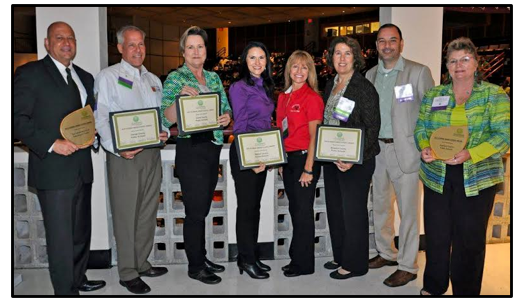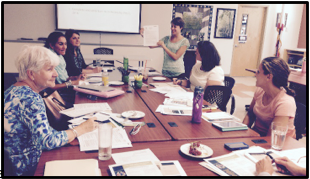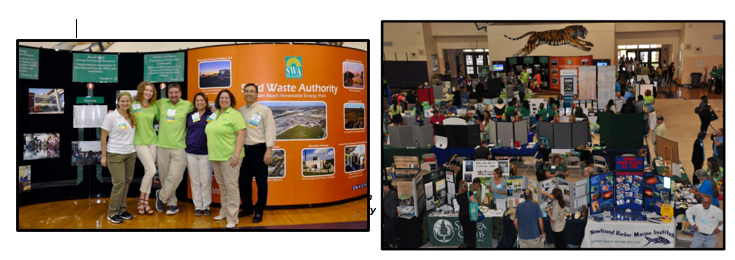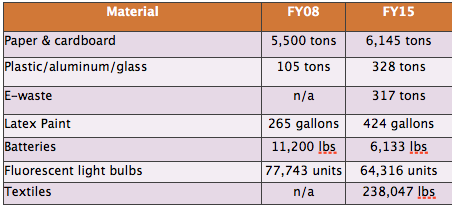The School District of Palm Beach County, Florida - Other School Department Based Activities
Celebrating 10 Years Of Wellness

CREATING HEALTHY SCHOOL ENVIRONMENTS BY GOING GREEN
Learn Green Conference
The Division of Support Operations in partnership with Florida Atlantic University held the 7th Annual Learn Green: Florida’s Green School Conference on November 16th, 2015 at Boynton Beach High School. Over 900 people were in attendance including over 50 local companies and organizations in the Gymnasium Exhibit Hall, 70 presentation sessions and over 100 volunteers of SDBPC staff and Boynton Beach High students. This event provided professional development opportunities for teachers, students, administrators and school staff to learn from each other and discuss new green school projects and ground-breaking initiatives.
Presentation sessions promoted the District’s wellness initiatives with topics such as, “Bite Into a Healthy Classroom with Nutrition Education,” “Creating Student Leaders in a Sustainable Food System,” “Get Moving – Get Thinking,” and “Florida Harvest of the Month: Farm to School Curriculum.” Session leaders included team members from the District’s own School Food Services, Slow Food USA, the Florida Department of Agriculture and Consumer Services and the University of Florida/ Institute of Food and Agricultural Sciences Extension.
Highlights included the opening ceremony, in which the Division of Support Operations received recognition from the Florida Green District Award Program. The School District of Palm Beach County was one of 9 districts who received the Florida Green School District Recognition.

In addition, Pine Jog Elementary School received a top award for being a Florida Green School. The ceremony concluded with speaker, Andrea Falken, U.S. Department of Education Green Ribbon Schools Director who praised the audience for their green initiatives and encouraged them to seek national resources and national recognition.
Green Schools Recognition Program
In partnership with The District’s Environmental and Conservation Services Department, FAU's Pine Jog Environmental Education Center implements the Green Schools Recognition Program (GSRP), which reaches schools across 40 cities in Florida. In 2016, sixty-one Palm Beach County District schools were applauded for their initiatives that promote a culture of sustainability. The Green Schools program inspires students and teachers to move toward community-based environmental stewardship through sustainability practices, community involvement, curriculum integration, outdoor classrooms, administrative support and innovation. These green practices have helped to create a healthy school environment District-wide.
One of the ways that the program cultivates a green school culture, is by promoting health and wellness. The Green School rubric awards points to schools that promote and model healthy living habitats, including healthy eating and physical activity.

2016 school-wide wellness projects included: school vegetable gardens, anti-drug campaigns, Jump Rope for Heart Day, afterschool yoga programs, Hoops for Hearts, and health and wellbeing newsletters.
Each year, cash prizes are given to top scoring schools in an effort to support ongoing green school initiatives and/or health and wellness projects. During the 2016 school year, over $8,500 was distributed to SDPBC schools for outstanding achievement including: Olympic Heights High School receiving $750 for being the 2016 Top Green School 3rd Place Winner. The following awards were also given:
- Green Principal of the Year Award and $500: Jennifer Galindo of Grassy Waters Elementary.
- Green Teacher of the Year Award and $500: Emily Sagovac of Elbridge Gale Elementary.
- Green Student of the Year Award and $500: Jessica Young of Palm Beach Central High.
In addition, Judge’s Choice Awards ranging from $250 to $500 were presented to 19 District schools from local businesses and community members.
For a full list of School District winners and more information about the Green Schools Recognition Program, visit: https://wcms.palmbeachschools.org/ecs/greenschoolsaward/
Green Schools Ambassador Program
The School District of Palm Beach County also partnered with Florida Atlantic University’s Pine Jog Environmental Education Center (PJEEC) to pilot a brand new initiative, the Green Schools Ambassador Program. The purpose of this pilot was to provide hands-on mentorship and assistance to schools new to the Green Schools Recognition Program (GSRP) or those schools desiring to move from the beginning level, “School of Promise”, to a higher level of achievement—either, “School of Quality” or the highest designation, “School of Excellence”. Some of our District schools have expressed a need for resources, guidance and support to move forward with their green school initiatives. The Green Ambassadors has helped us to better serve our green schools with the ultimate goal of the program being to grow the number and quality of green schools within the School District of Palm Beach County.
There were five Ambassadors and each were assigned between one to three schools with which to work (for a total of 11 schools in the pilot program). The mentoring process consisted of on-site meetings, which included a review of the Green School Recognition Program, the Green School Rubric, and the application process. Ambassadors shared resources that could assist or enhance each school’s green initiatives including grant opportunities, community contacts, and free/low cost programs and services. In addition, Ambassadors conducted a review, and assessed each school’s current green projects, then guided schools through a planning process to establish goals for green activities for the year. Ambassadors were available to answer questions via phone, text or email.
They attended Green Team meetings, and met with school administrators, parent groups and staff, if requested. In addition, each Ambassador helped their school work on its goals and projects, sending reminders, tips, and encouragement along the way. Enthusiastically, the Ambassadors worked with the ultimate goal in mind, which is, having each school achieve any level of GSRP recognition.
Overall, the pilot program was a success! Eight out of the eleven schools who participated submitted a GSRP application and received recognition. One school, Binks Forest Elementary, even received the highest level of recognition, Green School of Excellence, on their first try. In addition, each one of the Ambassadors reported successes, provided positive feedback, and committed to their participation for future years of the program.
Due to the success of this mentorship model, FAU Pine Jog received funding from the Community Foundation for Palm Beach and Martin Counties that will extend and expand this program for the next two years. The District wrote a letter of support that pledges our continued collaboration for successful implementation of the Green Schools Ambassador Program in our District schools.

10th Year Celebration: District Wellness Milestones
The Learn Green Conference
What is the annual Learn Green conference? Learn Green: Florida’s Green Schools Conference provides Florida students, teachers, administrators, facilities professionals, parents, and community members a one of a kind experience to learn how to make our schools greener. Over the past seven years, Learn Green has offered a unique opportunity for schools to gather information, connect with other schools, discover many green products, programs, and community resources from local and national companies and organizations, and develop next steps for going green.
Conference Chronology (2009-2014)
The first Learn Green Conference was held on November 11, 2009, at Pine Jog Elementary School, the first Gold LEED-certified public school in Florida. The event garnered the participation of over 300 participants and 30 exhibitors.
The second annual Learn Green took place on October 15, 2010, at Palm Beach Central High School. In its second year, the conference grew by leaps and bounds with an attendance of more than 700 participants, 65 exhibitors, and more than 50 conference sessions. Each year, presenters at Learn Green share their expertise on topics such as: Green School Recognition Program Workshop; Growing Green with Hydroponics; Greening through the Arts; Building Butterfly Gardens; Green Schools Roundtables; Low and No Cost Solutions to Going Green; Recycling 101; Touring Green Schools; Careers in the Green World; Creating Wildlife Schoolyard Habitats and much, much more. Learn Green also brings in nationally recognized leaders in the Green Schools movement as keynote speakers. In 2010, keynote speaker Jim McGrath, Executive Director and Founder of the National Green Schools Network, encouraged everyone to continue their green efforts and to become advocates in their schools, homes, and communities.
On November 11, 2011, the third annual Learn Green Conference went statewide with an invitation to all Florida schools which resulted in a record attendance of 866 representing sixteen Florida counties and four states. The 2011 Learn Green Conference highlights included keynote speaker, Rachel Gutter, Director of the Center for Green Schools at US Green Building Council; the incorporation of the School District of Palm Beach County’s Support Operations Division’s annual “Lessons Learned & Best Practices Workshop”, and over 90 exhibitors and 60 conference sessions. This was the first year that the conference took place on the beautiful, historical campus of the Alexander W. Dreyfoos School of the Arts in West Palm Beach.
The 2012 Conference took place on October 19, 2012, again at Dreyfoos SOA, and featured a special track that focused on “Healthy Kids and Healthy Communities” that was sponsored by a grant from the Robert Wood Johnson Foundation. Keynote speaker, Ms. Nona Evans, President and Executive Director of the Whole Kids Foundation inspired over 900 who were in attendance and shared her passion to end the childhood obesity epidemic in America. In addition, she shared how the Whole Kids Foundation is working to support schools and inspire families to improve children’s nutrition and wellness.
Over 900 attendees from all over Florida gathered for the fifth annual Learn Green on November 11, 2013. The keynote speaker, Stephen Ritz of the Green Bronx Machine, encouraged participants to understand that the greening of America starts with the greening of our hearts, minds and communities. The conference was held once again at the A. W. Dreyfoos School of the Arts with more than 85 new and returning exhibitors and 70 conference presentation sessions. A special panel session was added to discuss how Common Core Standards can be addressed through green school initiatives and projects.
At the 6th annual Learn Green Conference, over 900 attendees once again convened on the campus of A. W. Dreyfoos School of the Arts with more than 53 new and returning exhibitors. The event, which was held on October 20, 2014, boasted a keynote address presented byYalmaz Siddiqui, Office Depot’s Director of Environmental Strategy, and a choice of over 62 conference presentation sessions.
The featured keynote speaker at the 7th annual Learn Green Conference in November of 2015 was Andrea Suarez Falken, Director of U.S. Department of Education Green Ribbon Schools. In addition, for the first time ever, the Florida Green School Network (FGSN) presented its Green Schools and District Awards during the opening ceremony. The FGSN is a partnership of Florida DEP’s Office of Environmental Education, Florida Department of Health, Florida Department of Education, and Sustainable Florida who are committed to supporting healthy schools and green school initiatives.

(Left)2009 Presenting Sponsor, Audio Enhancement, in lecture hall where attendees gather to hear lectures and learn about green topics. (Right) The 2009 Learn Green Exhibit Hall at Pine Jog Elementary.

10th Year Celebration: District Wellness Milestones
Recycling in the District
The Environmental and Conservation Services Department is proud that 100% of our District schools participate in recycling at least one of the top five recyclable materials, including: cardboard, paper, plastic, glass and aluminum. This process has been a collaborative journey throughout the years and our District has evolved with regard to looking at recycling programs as green initiatives that support school wellness.
District-wide recycling initiatives began in the early 1990s when every school was set up with cardboard recycling. Over the next decade, schools began recycling paper, plastic, glass and aluminum. In 2007, our District confirmed its commitment to sustainability initiatives by adding a Sustainability & Recycling Coordinator position, who initiated Board Policy #7.197, the Waste Reduction, Materials Reuse & Recycling Policy. This policy was adopted by the School Board in 2009 and its purpose is to establish guidelines for the implementation of a District-wide waste reduction, materials reuse, and recycling program via institutionalizing the hierarchy of "reduce, reuse, and recycle." This Policy was designed to underscore the importance of resource conservation and encourage an overall ethic of environmental responsibility throughout the District. Through the successful implementation of this policy, the District has saved approximately $700,000 per year by reducing the cost of disposing waste while at the same time reducing the District's environmental impact. In addition, schools participating in recycling incentive programs have directly received tens of thousands of dollars in proceeds over the years to further support classroom-based green initiatives and projects.
To enhance recycling practices in the District, the ECS department initiated the Electronic Waste (E-Waste) recycling program in 2015-2016. E-Waste is generated on every school campus and at every District facility. The term “e-waste” can include many types Theof devices, as well as the many accessories associated with those devices. Unfortunately, most electronic equipment contains hazardous materials (e.g., heavy metals, fire retardants) which are harmful to human health and the environment if not disposed of properly. The District’s E-Waste Recycling Program provides standardized disposal of electronics in a way that is not only environmentally responsible, but that also adheres to federal standards for data destruction. In its first year, the program recycled over 20,000 units of e-waste, including CPUs, CRTs, LCD monitors and laptops, in addition to 138,787 pounds of miscellaneous e-waste.
